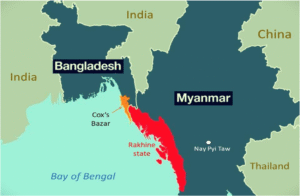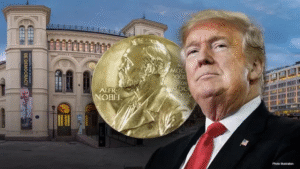Credit to picture by Naung Naung in Mizzima | DARZ-KKG’s Commentary for MMNN
In April 2024, Min Aung Hlaing met with representatives of all four major religions—Buddhist, Christian, Muslim, and Hindu—and publicly announced the allocation of land for religious buildings. It was a move widely seen as an attempt to soften his image and curry favor with religious minorities and neighboring governments.
A seemingly ordinary municipal approval in Naypyitaw has become the latest flashpoint for political opportunists. In Pyinmana Township, local nationalists have protested against a plot of land permitted for Islamic religious activities—a plot that, by all official accounts, was merely fenced, not built upon.
The land, said to have been allocated by junta leader Senior General Min Aung Hlaing himself, remains empty except for a simple boundary fence approved by the local development committee. “No mosque, no building, nothing has started,” one resident confirmed.
Yet, nationalist groups have turned this small piece of ground into a symbol of imagined “religious threat.” The Patriotic Myanmar Monks’ Association (Yangon) even petitioned Min Aung Hlaing on October 2 to revoke the permission entirely.
Meanwhile, Bullet U Hla Swe, USDP chairman for the Naypyitaw Council area, tried to downplay the issue, saying the permit did not specify mosque construction and could instead be used for a Muslim clinic or cemetery. He added, “There are already enough mosques. If they really want, they can apply later—but this permission is only for fencing.”
He further disclosed a striking imbalance in land distribution: while Christians, Hindus, and Muslims were each allocated only one to two acres, the military regime reserved about 100 acres for a Buddhist Religious Zone in Naypyitaw, including large plots for a Nunnery University, meditation center, and prominent monasteries.
“It’s like a hotel zone or industrial zone—just for Buddhism,” he said proudly.
This disparity speaks volumes about the double standards in Myanmar’s so-called “religious harmony.” What is presented as equal treatment of faiths in state-controlled media is, in reality, a carefully calibrated showpiece—designed for international optics, not genuine pluralism.
But behind that gesture, the same pattern repeated itself: one hand offering “permission,” while the other quietly fuels division. Nationalist networks quickly revived their anti-Islam campaigns, echoing the dangerous playbook of 2011–2016—when hate propaganda was used to distract from political failure and justify violence.
Now, as elections approach, some locals fear the timing is not accidental. “They’re creating religious conflict so people won’t focus on the election,” a Pyinmana resident observed.
Indeed, Myanmar’s repeated cycles of religious provocation have never been about faith—they have always been about control. Each time the regime faces public discontent, the “religious card” is played again, and minority communities are made scapegoats for a broken political system.
The fencing in Naypyitaw is not the real issue. It is the fencing of minds—through fear, division, and propaganda—that keeps Myanmar from achieving the peace and unity its people truly deserve.





